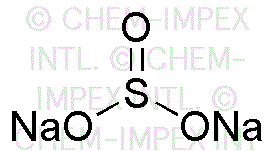Sodium sulfite is widely utilized in research focused on:
- Water Treatment: It acts as a reducing agent to remove chlorine from water, making it safer for consumption and industrial use.
- Food Preservation: Commonly used as a preservative in dried fruits and wines, it helps prevent spoilage and maintains freshness.
- Photography: In the development of photographs, it serves as a preservative for developing solutions, enhancing image quality and longevity.
- Pulp and Paper Industry: It is employed in the pulping process to reduce the environmental impact of bleaching agents, promoting a more sustainable production method.
- Analytical Chemistry: Used in various chemical analyses, it helps in the determination of metal ions and other compounds, providing accurate results for researchers.
General Information
Properties
Safety and Regulations
Applications
Sodium sulfite is widely utilized in research focused on:
- Water Treatment: It acts as a reducing agent to remove chlorine from water, making it safer for consumption and industrial use.
- Food Preservation: Commonly used as a preservative in dried fruits and wines, it helps prevent spoilage and maintains freshness.
- Photography: In the development of photographs, it serves as a preservative for developing solutions, enhancing image quality and longevity.
- Pulp and Paper Industry: It is employed in the pulping process to reduce the environmental impact of bleaching agents, promoting a more sustainable production method.
- Analytical Chemistry: Used in various chemical analyses, it helps in the determination of metal ions and other compounds, providing accurate results for researchers.
Documents
Safety Data Sheets (SDS)
The SDS provides comprehensive safety information on handling, storage, and disposal of the product.
Product Specification (PS)
The PS provides a comprehensive breakdown of the product’s properties, including chemical composition, physical state, purity, and storage requirements. It also details acceptable quality ranges and the product's intended applications.
Certificates of Analysis (COA)
Search for Certificates of Analysis (COA) by entering the products Lot Number. Lot and Batch Numbers can be found on a product’s label following the words ‘Lot’ or ‘Batch’.
*Catalog Number
*Lot Number
Certificates Of Origin (COO)
This COO confirms the country where the product was manufactured, and also details the materials and components used in it and whether it is derived from natural, synthetic, or other specific sources. This certificate may be required for customs, trade, and regulatory compliance.
*Catalog Number
*Lot Number
Safety Data Sheets (SDS)
The SDS provides comprehensive safety information on handling, storage, and disposal of the product.
DownloadProduct Specification (PS)
The PS provides a comprehensive breakdown of the product’s properties, including chemical composition, physical state, purity, and storage requirements. It also details acceptable quality ranges and the product's intended applications.
DownloadCertificates of Analysis (COA)
Search for Certificates of Analysis (COA) by entering the products Lot Number. Lot and Batch Numbers can be found on a product’s label following the words ‘Lot’ or ‘Batch’.
*Catalog Number
*Lot Number
Certificates Of Origin (COO)
This COO confirms the country where the product was manufactured, and also details the materials and components used in it and whether it is derived from natural, synthetic, or other specific sources. This certificate may be required for customs, trade, and regulatory compliance.


